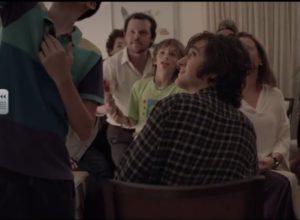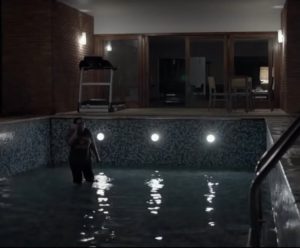
Class and Gender in Muylaert’s A que horas ela volta? and Mãe só há uma
Mediático is delighted to present a piece by regular contributor Natália Pinazza. Pinazza is an associate lecturer at Birkbeck, University of London. She holds a PhD and MA from the University of Bath and a BA from the University of São Paulo. She undertook a UNESCO fellowship at the University of Ottawa, Canada. Her research interests include Latin American and Lusophone cinema and transnational film theory. She is the author of Journeys in Argentine and Brazilian Cinema: Road Films in a Global Era and co-editor of World Cinema Directory: Brazil, and World Film Locations: São Paulo. You can follow her on Twitter at @natiapina.
Alongside Latin American films such as Aquarius (Kleber Mendonça Filho, 2016), Neruda (Pablo Larraín, 2016), Hermia & Helena (Matías Piñeiro, 2016), Rara (Pepa San Martín, 2016), Lupe Under the Sun (Rodrigo Reyes, 2016), and The Untamed (Amat Esclante, 2016), the 2016 BFI London Film Festival programme included Anna Muylaert’s Don’t Call me Son (Mãe só há uma 2016). Loosely based on a true story, Don’t Call me Son centres on Pierre, a 17-year-old who abruptly learns that he was kidnapped as a baby at the maternity hospital and that the person who raised him, the only mother he knew, is actually his kidnapper (Dani Nefussi plays the role of both mothers). Similar tensions between two mother figures from different socio-economic backgrounds were also explored by Muylaert in her previous film, The Second Mother (A que horas ela volta?), Brazil’s entry for the foreign-language category at the 2015 Academy Awards.
The Second Mother centres on an emblematic figure of the Brazilian society, the hardworking housekeeper, who after a long time living in a household becomes a mother figure to her employer’s children. Like many women in Brazil, the protagonist Val leaves the northeast of the country to work in the Southeast, more precisely São Paulo. Regina Casé, who plays the role of Val, wrote the screenplay alongside Muylaert. Interestingly, Casé presented a TV show entitled “Esquenta” (“Heat”) on Globo, Brazil’s biggest TV network, in which she displayed an ability to communicate with a socially diverse audience. This versatility also comes across in Case’s award-winning performance of this well-known figure of Brazilian society. The film’s focus on the maid and its conscious exploration of the domestic sphere, allow local readings of the film that “hit home”.
The interiors of the house are imbued with social meaning as they reflect a veiled and silent hierarchical structure, which conveys that this “family member” is in fact a migrant, poorer, and ultimately a servant. Arguably a legacy of the nurses and nannies from the slavery past, these women inserted in an upper middle-class household often live in a small room at the back of their employers’ house. The recurrence of this practice in Brazilian society has impacted on the very architecture and conception of apartments, which led to the creation of “o quarto da empregada” (the maid’s room). Significantly, Val’s daughter, who refutes the social order that informs these spaces, is a prospective architecture student.
In his analysis of The Second Mother’s use of space as a strategy to convey class conflict, Tiago de Luca observes that the rich family members are framed as “the backdrop against which the maid is depicted […] Val is seen on the left of the frame within the kitchen eavesdropping on the conversations taking place at the table in the background on the right. It is also freighted with symbolism not only because it conveys clearly demarcated spatial separation between bosses and servants but also because it reinforces, through camerawork, Val’s characterization as a subject without the possibility of social mobility” (forthcoming 2017).
Although both The Second Mother and Don’t Call me Son are set in São Paulo, the background of the city is not explored as the locus of class conflict as it is in other contemporary films such as Linha de Passe (Walter Salles and Daniela Thomas, 2008) and O Invasor (Beto Brant, 2002). Like The Second Mother, Don’t Call me Son takes place primarily in the domestic sphere. There are shots of characters interacting in the kitchen, the living room, and the bedroom, as well as scenes that show Pierre in his bathroom. The film’s focus on the family unit and the exploration of the internal domestic environment in these films testifies to ongoing changes in Brazilian society, which have transformed previously demarcated social boundaries and spaces. Characters such as Pierre and Val’s daughter stand for an emerging class, namely “class C”, which has now “invaded” spaces such as shopping malls and airports that until recently were solely inhabited by the elite and the upper middle class. Almost half of the population of Brazil, a country historically marked by its abysmal inequalities, now constitutes the so-called class C, a “new middle class” with unprecedented access to consumerism. Therefore, Pierre and Val’s daughter’s boundary crossing and “invasion” of upper middle-class spaces needs to be understood in the context of the social and economic changes that Brazil has undergone over the past 20 years.
The Second Mother and Don’t Call me Son exhibit tensions surrounding mother figures (the one who raises the children versus the one who gives birth to them), allowing the films to focus attention on the ongoing changes of Brazilian society from within the family unit. Actually, both original titles make direct (mãe) or indirect (ela) references to the mother. The original title in Portuguese of Don’t Call me Son is Mãe só há uma, which translates as “There is only one mother”, whereas Que horas ela volta? is the original title for The Second Mother and translates as “What time does she come back?” The earlier “mãe” (“mother”) refers to the fact that Pierre only validated one person as his mother while the later “ela” (“she”) is part of a line said by Val’s daughter. Val explains her absence to her daughter, who says that as a child she would miss Val and ask “what time does she come back?”
While The Second Mother focuses on a female maid, who performs a gendered and stereotypical role, Don’t Call me Son presents the viewer with conflicting and competing models of what it is or means to be male or to be a “son” as indicated in its very title. This tension is played out in the relationships between Pierre, his biological father, and his younger brother, who fits the stereotype of a Brazilian middle-class schoolboy and lives up to more traditional expectations of what a male should be: he likes football, he flirts with girls, and he takes martial arts classes, which are very popular in Brazil. Pierre, on the other hand, dresses up in drag and his sexuality is fluid. He is attracted to both boys and girls. After a while, the film shows that Pierre is not the only one struggling to adjust to his “new family” and also that his biological family does not fully accept him as they get to know him. So the film is very much about belonging, acceptance and identity building. The viewer witnesses Pierre’s transition from negotiating his sexuality to facing the threat of losing his identity (people literally start calling him by another name, “Felipe”).
The film performs this identity building process through the use of photography as a narrative device. There are many scenes in which Pierre takes pictures of himself in the bathroom and is followed by the media and paparazzi. His extended family takes a selfie with him when they meet for the first time. Pierre’s identity is essentially an on-going process and there are a number of narrative strategies used to emphasize the characters’ feelings and heighten the sense of drama. There are also many scenes where two characters share the same frame: one is out of focus whereas the other one, usually the speaker, is in focus. Such a play on image focus individualises and validates each character as they express themselves.

Don’t Call me Son develops this theme of class conflict within the family unit. Pierre goes from living in a working class family environment to an upper middle-class household. Pierre is often framed in medium shots within the house, creating a stark contrast between his previous and later houses. Pierre and his sister’s biological family families offer material comforts as an attempt to overcompensate for the children’s struggle which is overwhelming for the kids. On the one hand, there is the happiness of the biological parents in meeting their children after years and on the other hand, the children feel like they were being stolen again. Indeed, even with all this material comfort Pierre does not belong to his biological family and the film extensively explores Pierre’s feelings of displacement in an upper-middle class environment. When Pierre’s biological parents show him the house or when he meets his extended family, there are many voices and ambient noises, creating a sense of chaos that alienates the character. In showing how Pierre refuses to embrace that lifestyle, the film offers a comment on our capitalist society in which it is believed that everything can be bought. Pierre’s values do not match the ones of his upper middle class biological family. He enjoys living an underground life and he feels like he has been kidnapped from that life.
Val’s daughter both sanctions and rejects the social order that has kept her mother in a subservient role: she sits with the family and she is a good student, challenging preconceived notions of the underachievement of poorer classes. Val’s daughter’s refusal to align with upper-middle class conventions peaks in the sequence in which she jumps into the swimming pool, a powerful visual signifier of the boundaries between rich and poor, employer and servant. Val is, at first, ashamed by her daughter’s boundary crossing, which starts to de-naturalise the demarcated spaces assigned to her. This process is illustrated when Val gets in the almost empty swimming pool for the first time after living in the house for many years. Val resigns and insists that her grandchild come to live with them. The film, then, represents a break with a historical cycle characterised by housekeepers who become “second mothers” to upper-middle class kids, but cannot raise their own. In recent years, there have also been a number of changes in the rights of domestic workers in Brazil.

The Second Mother and Don’t Call me Son make a significant contribution to an ongoing discussion about class, belonging and identity in Brazil. As I have described, through the conscious exploration of the domestic sphere, the films point to the fact that previously demarcated spaces such as the swimming pool, the kitchen and the maid’s room are portrayed as sites of power struggles in the context of the emergence of a new class. In both films, questions of gender and class revolve around the tension within the family unit, especially in relation to the mother figure. The films, then, channel the “invasion” by subjects belonging to this new class into the heart of the upper-class family, charting social transformations from within the family unit, suggesting that Brazil as a nation is still negotiating how the “mother” figure should be conceived.
References
De Luca, Tiago (2017) ‘“Casa Grande & Senzala”: Domestic Space and Class Conflict in Casa grande and Que horas ela volta?’ in Mariana Cunha & Antonio M. da Silva (eds) Space and Subjectivity in Contemporary Brazilian Cinema (London: Palgrave).







you spelt the authors name wrong the first time
Thank you. I will see to this or check whether my coeditor already corrected this mistake.